
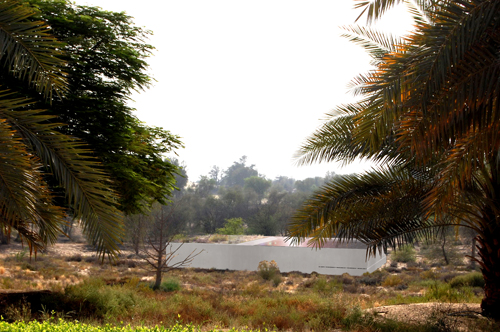
Concentrated photovoltaic (CPV or HPVC) technology concentrates sunlight through a lens onto a high performance solar cell, thus increasing the electricity generated over conventional PV panels. Typical photovoltaic panels only convert about 10 to 15 percent of incoming light into energy. CPV cells utilize multijunction photovoltaics which can reach efficiencies of 40 percent. Typically the CPV solar cell lies directly beneath the fresnel lens or parabolic mirror concentrator.
In the Ibn Al-Haytham Pavilion, this type of system is modified to create beams of vertical light with the power of 800 suns by concentrating sunlight through fresnel lenses at the roof. These beams are then re-concentrated at the raised floor level by a second fresnel lens field and onto the CPV cells which are arrayed in a naturally cooled plenum space at ground level.

The beams are set against an interior of mirrored walls to increase the effect of the visual field. The relative darkness of the room that houses the beam field insures that the beams are clearly visible inside it. The beams themselves change position as the heliostatic dual-axis hinges follow the exact location of the sun. This ever-changing composition is visible in two locations: the horizontal viewing aperture at the North elevation, and from within the camera obscura room on the South side of the pavilion.

View as seen from the North viewing aperture. The aperture itself is completely open with the concrete shell creating a cantilevered structure with steel reinforcing. Since each beam has the real ability to set fire to anything combustible in its path, the inside of the aperture has protective glass.

The first camera obscura was built by Arab scientist Abu Ali Al-Hasan Ibn Al-Haytham, born in Basra (965-1039 CE), who carried out practical experiments on optics in his “Book of Optics”. In his experiments, Ibn Al-Haytham used the term Al-Bayt al-Muthlim, translated in English as dark room. In the experiment he undertook in order to establish that light travels in time and with speed, he wrote: “If the hole was covered with a curtain and the curtain was taken off, the light traveling from the hole to the opposite wall will consume time.” He reiterated the same experience when he established that light travels in straight lines. A revealing experiment introduced the camera obscura in studies of the half-moon shape of the sun’s image during eclipses which he observed on the wall opposite a small hole made in the window shutters. In his famous essay “On the Form of the Eclipse” (“Maqalah-fi-Surat-al-Kosuf”) he commented on his observation: “The image of the sun at the time of the eclipse, unless it is total, demonstrates that when its light passes through a narrow, round hole and is cast on a plane opposite to the hole it takes on the form of a moon-sickle.”
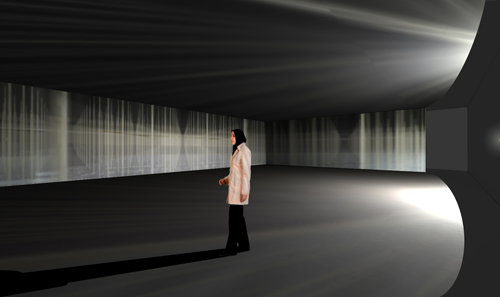
Estimated (and perhaps optimistic) statistics:
> Area of lens field: 576 square meters
> Assumed operating efficiency of system: 15%-30% (40% cell efficiency – loss from lenses, angle obstructions, and heliostatic tracking)
> Resulting peak energy capacity: 86 KW – 172 KW
> Typical output per day: 1200 KWH
> Typical output per year: 400 MWH
> Cost per MWH: AED 300
> Cost savings generated per year: AED 120,000
> Construction cost: AED 4,000,000
> Payback: approx. 30yrs (cultural payback hopefully sooner than that)


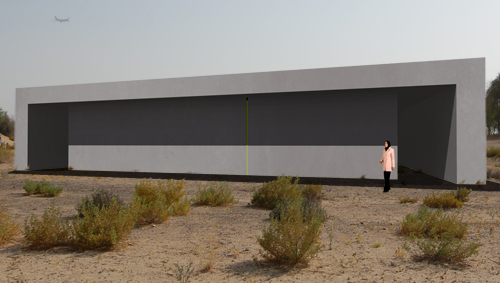
Entrance to the camera obscura room from the South Elevation
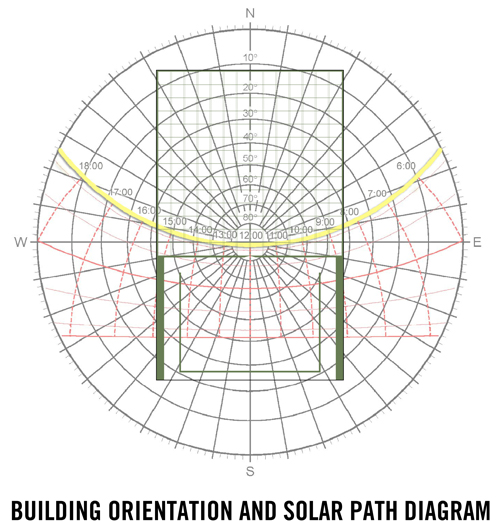
Related Posts
2 Comments
Add comment Cancel reply
This site uses Akismet to reduce spam. Learn how your comment data is processed.

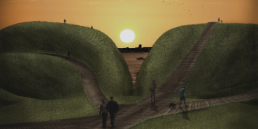
This is great. I’ll be speaking about this project, and others from the LAGI, Wednesday (Oct 13) at the School of Interactive Arts & Technology at Simon Fraser University, Vancouver, Canada.
I look forward to exploring this amazing project with you tomorrow.